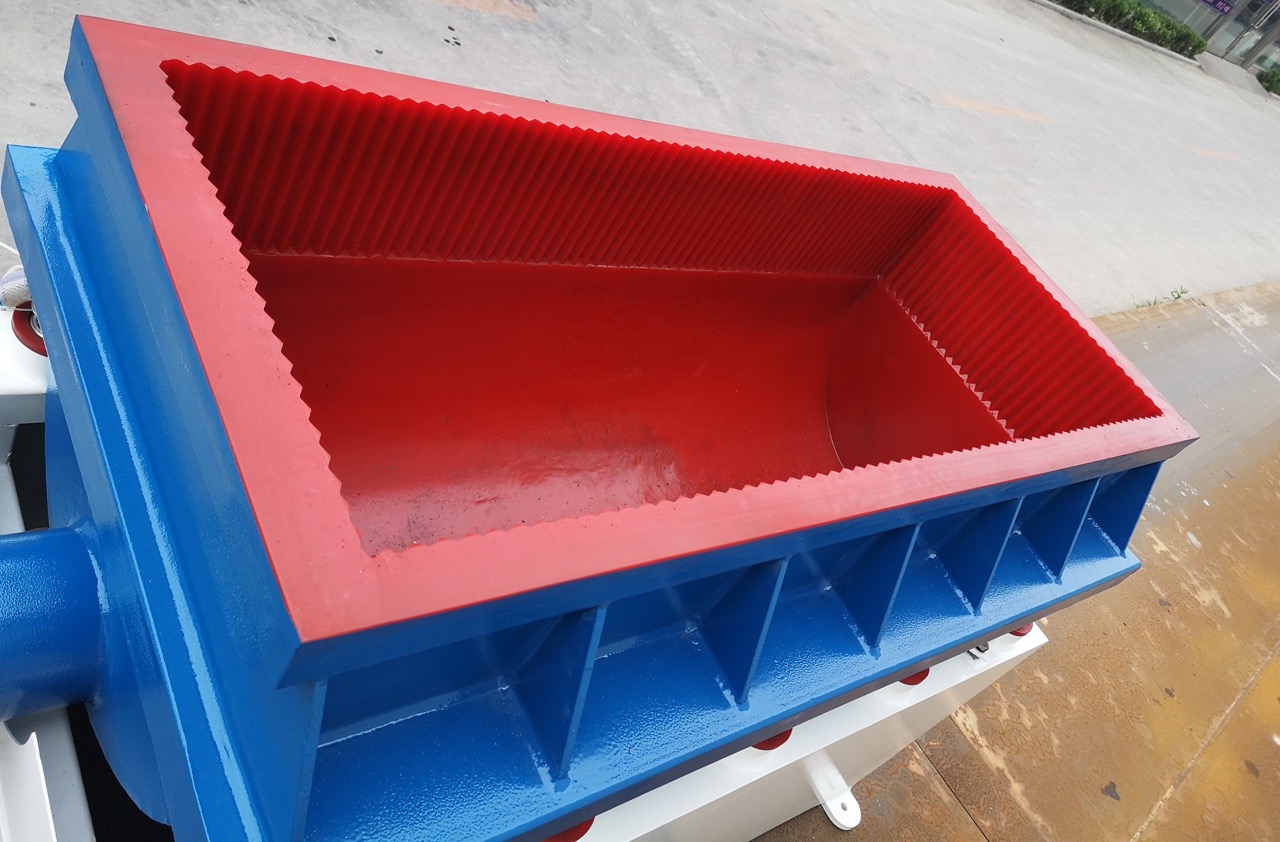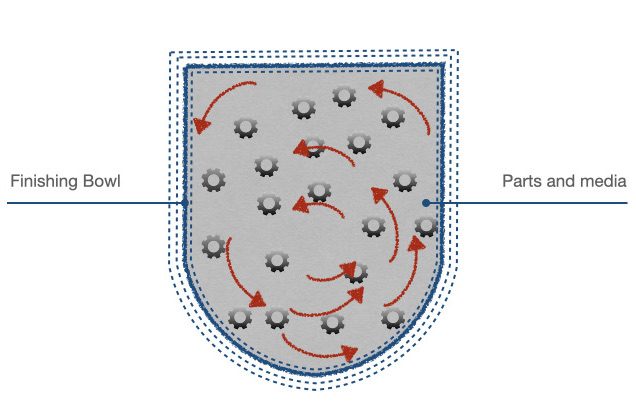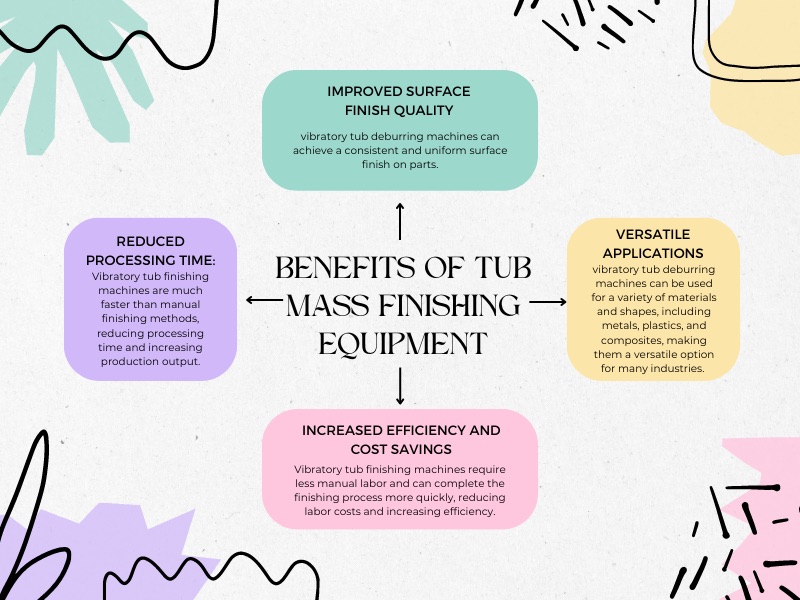

Vibratory tub finishing is a mass finishing process used to deburr, polish, and clean metal and plastic parts. It involves placing parts, finishing media, and water or other compounds into a large tub or container. The tub is then vibrated at high frequencies to create a tumbling action that causes the media to rub against the parts, removing burrs and smoothing the surface.
Vibratory tub finishing offers several benefits for metal finishing processes, including:
Improved surface finish quality: Vibratory tub finishing can produce a smooth, even surface finish that is free from burrs, sharp edges, and other imperfections.
Reduced processing time: The vibrating action of the tub can remove burrs and other imperfections more quickly than manual finishing methods, reducing processing time and increasing efficiency.
Increased efficiency and cost savings: Vibratory tub finishing can handle large quantities of parts at once, reducing the need for manual labor and potentially saving money on labor costs.
Versatile applications: Vibratory tub finishing can be used on a wide range of parts and materials, including metal, plastic, and ceramic, making it a versatile finishing process.
In summary, vibratory tub finishing is a cost-effective and efficient way to deburr, polish, and clean metal and plastic parts. Its high-speed vibrations and large tub size can handle large quantities of parts at once, reducing processing time and increasing efficiency. Additionally, its versatility makes it a popular choice for a wide range of parts and materials.
A vibratory tub finishing machine consists of a large tub that is typically made of steel and is lined with a polyurethane (PU) coating to protect the parts being finished. The machine also includes a vibratory drive unit, which consists of an electric motor and an eccentric weight system that generates high-speed vibrations to agitate the contents of the tub.

In addition, the machine options a control panel that allows the operator to adjust the vibration intensity, as well as other optional settings such as a soundproof cover, a media separation system, and more.
The vibratory tub finishing process involves several steps:
Load the parts: The operator loads the parts to be finished into the tub, along with the appropriate finishing media and a water or chemical compound.
Start the machine: The operator turns on the vibratory drive unit, causing the machine to vibrate at high frequencies.
Agitation: The vibrating action of the machine causes the media to rub against the parts, removing burrs and smoothing the surface.
Separation: Once the finishing process is complete, the operator stops the machine and uses the media separation system to separate the finishing media from the finished parts.
Rinse and dry: The finished parts are then rinsed and dried to remove any remaining media or compounds.
Vibratory tub finishing is a highly effective method for deburring, polishing, and cleaning metal and plastic parts. The vibrating action of the machine generates a tumbling motion that causes the media to rub against the parts, removing burrs and imperfections and leaving behind a smooth, even surface finish.

Mass finishing equipment offers many benefits over traditional finishing methods, including:
Improved surface finish quality: vibratory tub deburring machines can achieve a consistent and uniform surface finish on parts. By using the right media, they can remove burrs, polish, and even out surface imperfections, resulting in a smooth, high-quality finish.
Reduced processing time: Vibratory tub finishing machines are much faster than manual finishing methods, reducing processing time and increasing production output. The machine can process multiple parts simultaneously, saving time and labor costs.
Increased efficiency and cost savings: Vibratory tub finishing machines require less manual labor and can complete the finishing process more quickly, reducing labor costs and increasing efficiency. They also use less water and abrasive media compared to traditional methods, resulting in cost savings.
Versatile applications: vibratory tub deburring machines can be used for a variety of materials and shapes, including metals, plastics, and composites, making them a versatile option for many industries. They can be used for surface preparation, deburring, polishing, and even cleaning parts.
Overall, vibratory tub finishing machines offer many benefits for finishing parts, including improved surface finish quality, reduced processing time, increased efficiency and cost savings, and versatile applications.
Vibratory tub finishing machines are used in a variety of industries for finishing parts and components. Some of the industries that commonly use these machines include:
Automotive industry: Vibratory tub finishing machines are used for finishing engine components, brake components, suspension parts, and other metal components used in vehicles. The machines can remove burrs and sharp edges, smooth out rough surfaces, and polish the parts to a high shine.
Aerospace industry: vibratory tub deburring machines are used for finishing aerospace components, such as turbine blades, engine components, and landing gear parts. The machines can remove burrs and sharp edges, improve the surface finish, and enhance the performance and durability of the components.
Medical device manufacturing: Vibratory tub finishing machines are used for finishing medical devices, such as implants, surgical instruments, and orthopedic devices. The machines can remove burrs and sharp edges, smooth out rough surfaces, and improve the biocompatibility of the components.
Other industries: vibratory tub deburring machines are also used in other industries, such as jewelry manufacturing, electronics manufacturing, and consumer goods manufacturing. They can be used for finishing a variety of materials, including metals, plastics, and composites.
In conclusion, vibratory tub deburring machines are used in a variety of industries for finishing parts and components. They can improve the surface finish quality, reduce processing time, increase efficiency and cost savings, and have versatile applications.
To achieve the desired finish on parts, it is important to choose the right media for the job. There are many types of media available, including ceramic, plastic, and steel. Each type of media has different properties that make it suitable for different applications. For example, ceramic media is commonly used for heavy cutting and deburring, while plastic media is used for light cutting and surface finishing.
Proper maintenance and cleaning of the equipment is also important for achieving consistent results. The machine should be cleaned regularly to remove any buildup of debris or media residue. The media should also be changed regularly to maintain its effectiveness.
Safety is a key consideration when using vibratory tub deburring machines. Operators should be trained on how to use the machine safely and should wear appropriate personal protective equipment, such as gloves and safety glasses. The machine should be placed on a level surface and should be properly grounded to prevent electrical hazards. The machine should also be turned off and unplugged when not in use.
In vibratory tub finishing, surface roughness can be measured using the same techniques as in other surface finishing processes. The most common technique for measuring surface roughness is the stylus profilometer, which uses a stylus with a very small tip to measure the height of surface irregularities. Other techniques such as optical profilometry, atomic force microscopy, and scanning electron microscopy can also be used.
Regardless of the technique used, it is important to follow standardized procedures for surface roughness measurement. Standards such as ISO 4287 and ASME B46.1 provide guidelines for measuring surface roughness and ensure that results are consistent and reliable.
It is important to note that the type of media and process parameters used in vibratory tub finishing can affect the surface roughness of the finished part. Therefore, it is important to choose the appropriate media and process parameters to achieve the desired surface roughness for the specific application.
Vibratory tub finishing is a highly effective surface finishing process that offers several benefits and has a wide range of applications across several industries. By understanding the process, choosing the appropriate media and process parameters, and properly maintaining the equipment, operators can ensure consistent and reliable results, and achieve the desired surface finish for their specific application.